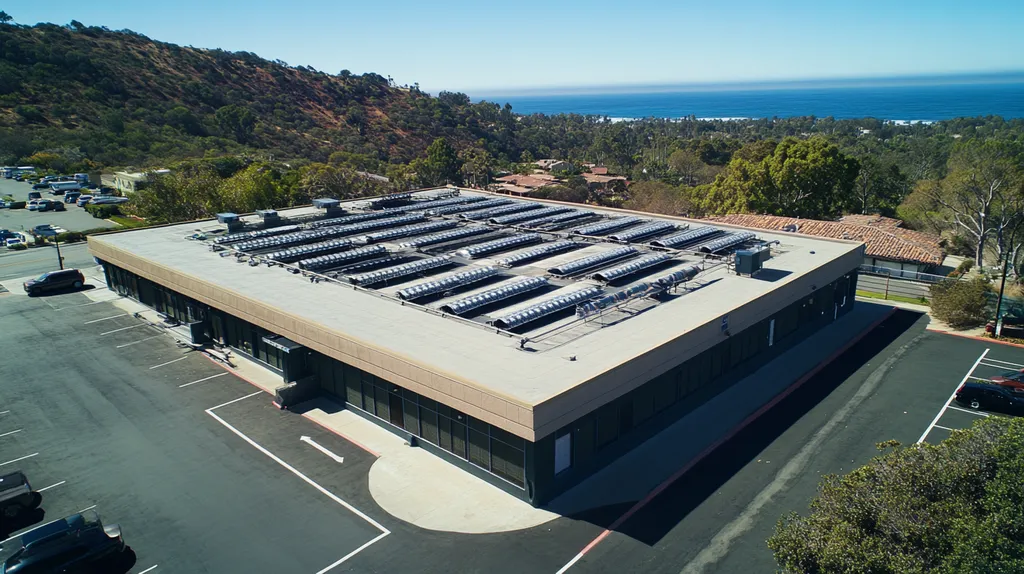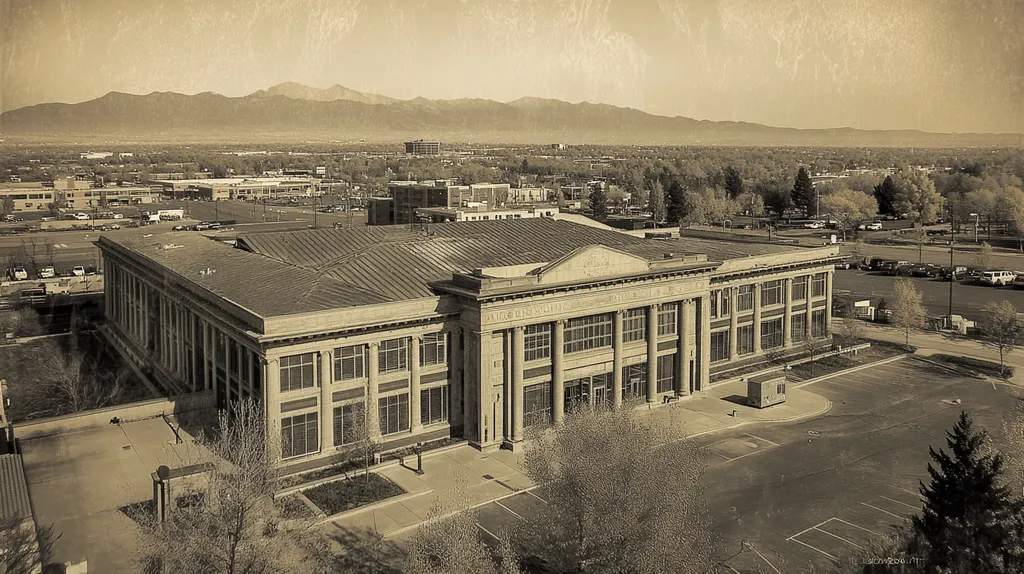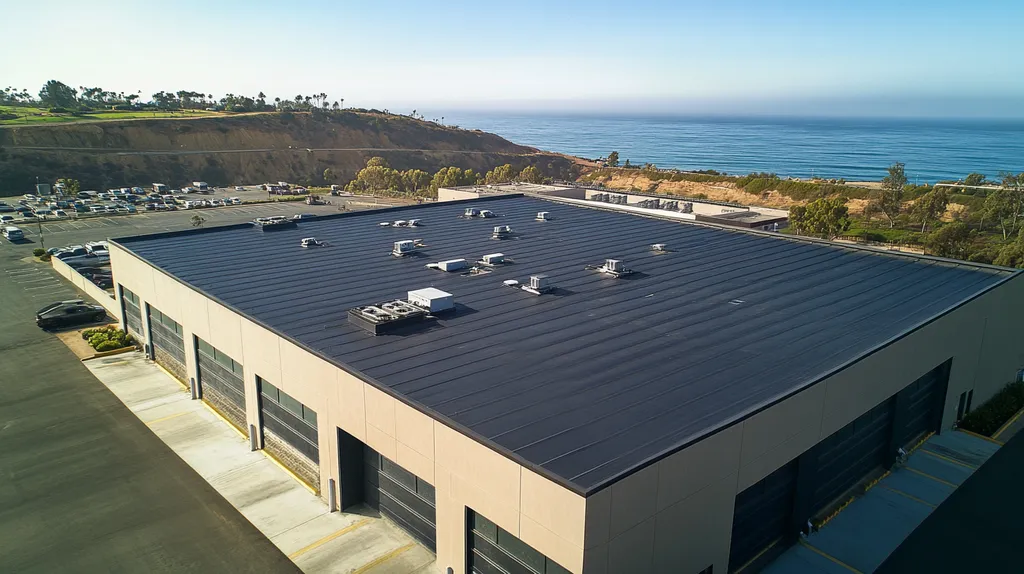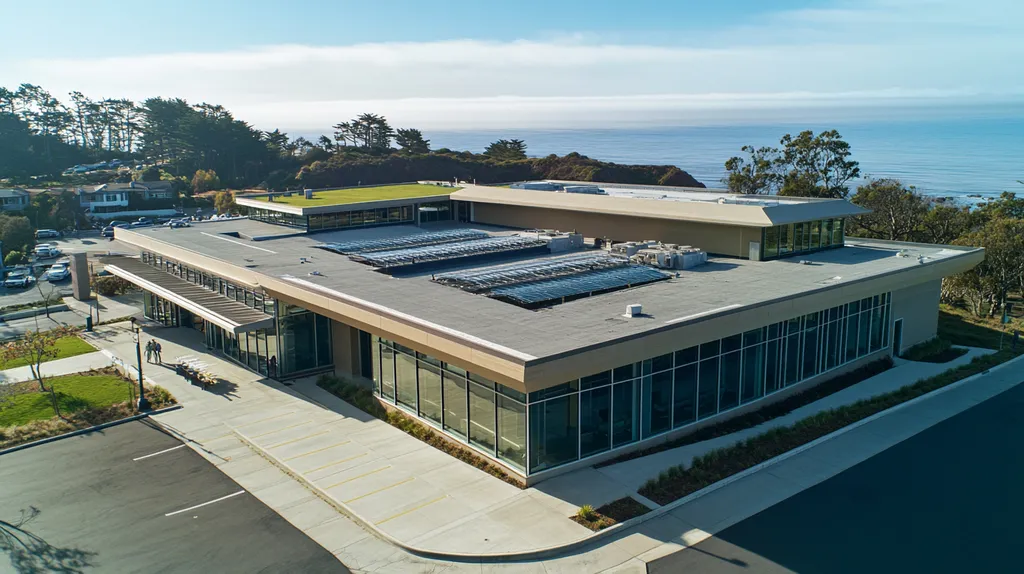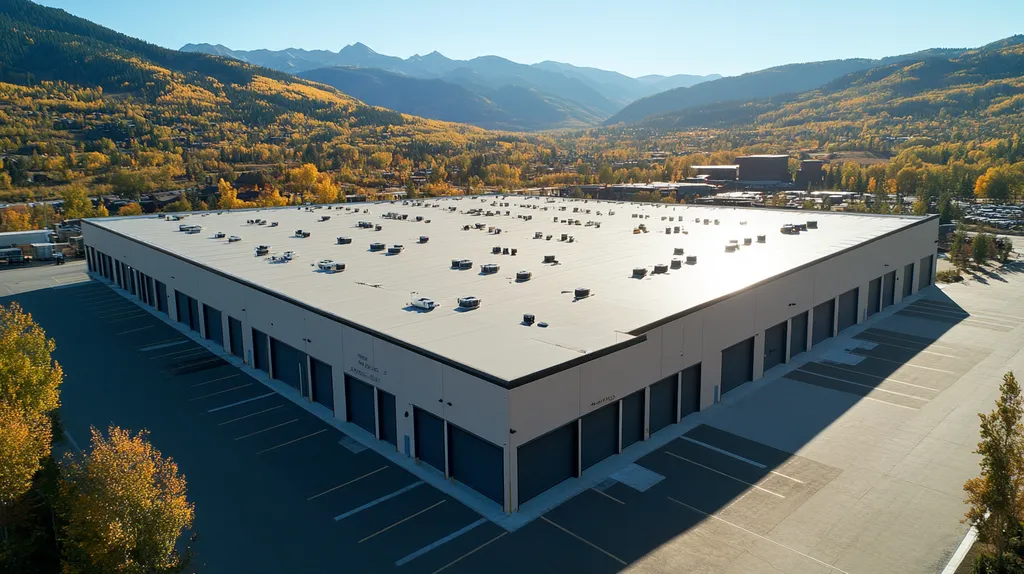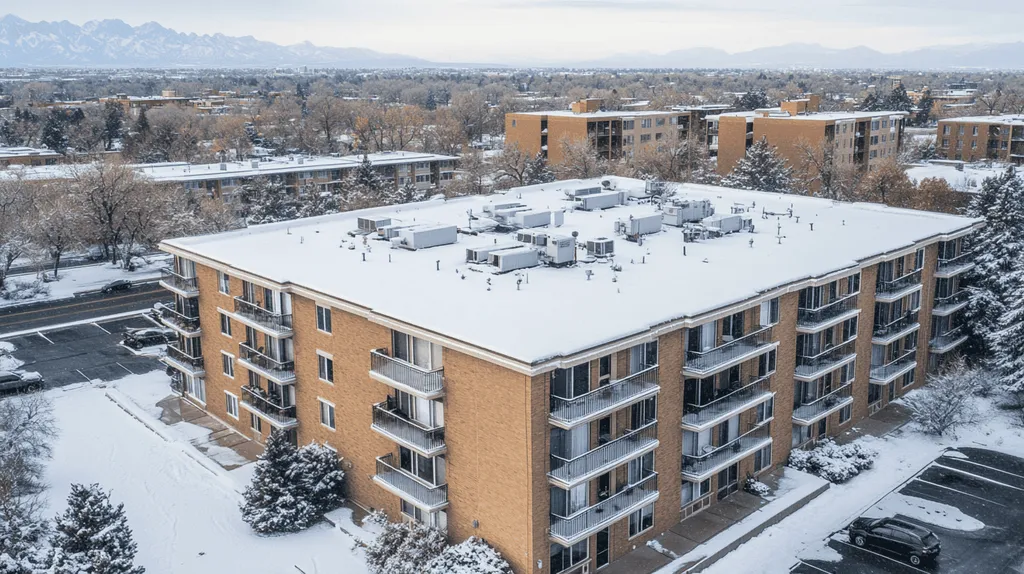Moisture damage from inadequate roof venting costs commercial property owners millions annually in repairs and premature roof replacements. Industry studies show that over 40% of flat commercial roofs fail before their expected lifespan due to ventilation issues.
Understanding proper venting practices is crucial for protecting these significant structural investments. Without effective ventilation, trapped moisture can devastate roofing materials, compromise insulation, and create dangerous mold conditions.
This comprehensive guide examines the critical elements of roof venting, from basic principles to advanced strategies, equipping property owners and facility managers with essential knowledge to prevent moisture-related failures.
SECTION 1: THE BASICS EXPLAINED
Effective venting is not just an optional feature for flat commercial roofs; it is a critical necessity. Failing to implement proper ventilation can lead to devastating moisture accumulation, resulting in costly damage that could jeopardize a building’s overall structural integrity. Alarmingly, over 50% of roofing failures are attributed to insufficient venting systems. This makes it essential for property owners and facility managers to grasp the fundamentals of roof venting to safeguard their investments and avoid premature roof failure.
What It Is (In Plain Language)
Roof venting is the strategic placement of openings that facilitate air circulation throughout the roof structure. This airflow is vital for regulating temperature and moisture levels, particularly in flat roofs, where pooling water can be an ongoing concern. Proper ventilation helps to prevent condensation, which can become a significant issue if overlooked.
Various types of vents, including ridge, soffit, and turbine vents, each serve a specific function in ensuring optimal airflow. By employing a combination of these systems, property owners can create an equilibrium that disrupts moisture build-up and fosters a healthier roofing environment.
Due to their minimal slope, flat roofs face unique challenges, making effective venting even more essential. Without adequate ventilation, trapped moisture may lead to severe structural issues, rising energy costs, and the proliferation of mold.
In essence, roof venting is about ensuring healthy airflow to protect both the roof and the overall integrity of the building. It is a fundamental aspect of roof maintenance that should never be underestimated.
Why It Matters (To Your Building)
The primary purpose of roof venting is to alleviate moisture-related challenges that can drastically reduce a building’s lifespan. When insufficient ventilation exists, water vapor from daily activities can gather and lead to harmful condensation.
This condensation poses risks such as insulation degradation, mold growth, and structural deterioration over time. Such issues compromise not only the roof but also the health of the building’s environment as a whole.
Moreover, moisture damage significantly inflates operational costs. Studies reveal that buildings designed with proper venting can enjoy energy cost reductions of up to 25%. Such savings directly bolster the financial well-being of property owners.
Additionally, mold can create health risks for occupants, introducing potential liability concerns for property owners. Thus, ensuring effective roof venting goes beyond basic maintenance; it is crucial for both safety and fiscal responsibility in building management.
How It Works
The mechanics of roof venting revolve around the principle of airflow. Warm air rises and escapes through vents, allowing cooler external air to enter and circulate. This natural process helps regulate temperature and reduces humidity levels within the roofing system.
In flat roofs, this principle is executed through exhaust vents that draw heated air upward while intake vents enable cooler air to flow in from lower areas. The strategic placement of these vents is critical; positioning exhaust vents near the warmest points maximizes airflow efficiency.
Furthermore, builders often advocate for insulated ventilation systems to enhance their effectiveness. These systems assist in maintaining a consistent air temperature, further curbing moisture buildup.
By understanding how roof venting operates, property owners and facility managers can make informed decisions and implement best practices tailored to their building’s needs. Effective venting is a vital line of defense against moisture damage and a key factor in prolonging the lifespan of flat commercial roofs.
SECTION 2: PRACTICAL APPLICATIONS
Implementing effective venting for flat commercial roofs is not just a good practice; it’s absolutely essential. Research shows that inadequate ventilation can lead to moisture buildup, resulting in expensive repairs and threatening the structural integrity of your building. By understanding the practical applications of venting systems, property owners and facility managers can substantially minimize risks associated with moisture damage. This section explores common uses of venting systems, identifies crucial situations when effective venting is necessary, and examines how different roofing systems interact.
Common Uses & Examples
Venting systems are critical in maintaining balanced air pressure and moisture control in various commercial settings. They are often utilized in warehouses, retail spaces, and manufacturing facilities. For example, a distribution center with a flat roof benefits greatly from a mix of passive and active ventilation approaches to ensure steady airflow.
Common applications include roof-mounted exhaust fans that actively expel moisture-laden air and ridge vents that allow cooler air to enter. This combination significantly prevents heat accumulation, which can deteriorate roofing materials over time.
In colder climates, it’s especially important to incorporate insulated or conditioned roof spaces into the venting strategy. This step helps avoid condensation forming between the insulation and the roofing membrane, preserving the building’s overall integrity.
Ultimately, commercial properties with well-executed venting systems frequently see extended roof lifespans, and facility managers often report fewer maintenance challenges when proactive ventilation strategies are in place.
When You Need It Most
The level of required ventilation varies by roof type and location, but certain conditions trigger the need for enhanced venting systems. Roofs situated in humid climates are particularly vulnerable to moisture-related issues. Inadequate ventilation in these areas significantly increases the risk of mold growth and structural problems.
Specific conditions, such as the winter or rainy seasons, demand extra caution. These times increase the likelihood of moisture condensing and lingering, making robust ventilation systems even more crucial. Regular roof inspections can reveal areas where stagnant air may lead to serious moisture concerns.
Furthermore, buildings with high-occupancy areas—like gyms or commercial kitchens—generate considerable humidity that requires advanced venting solutions. By evaluating the unique requirements of each property, facility managers can better customize their ventilation strategies, addressing potential moisture issues before they escalate.
In short, proactive venting measures can help property owners avert costly repairs and prolong the lifespan of their roofing systems.
Interactions With Other Systems
Effective venting must work in concert with other building systems to achieve optimal functionality. The relationship between a building’s HVAC system and roof ventilation is pivotal. While an efficient HVAC system helps regulate indoor air quality, it should collaborate seamlessly with roof vents to manage moisture effectively.
Consideration of waterproofing systems is also essential when implementing ventilation solutions. Incorrectly placed vents can lead to leaks or infiltrations, undermining the benefits of proper venting. Ensuring coordination between roofing and venting design allows both systems to operate effectively without compromising the building’s durability.
The dynamics between insulation and ventilation further emphasize the need for balance. Inadequate insulation can create condensation problems that even the most advanced venting systems can’t fully mitigate. Pairing properly installed insulation with well-planned vent placement maintains consistent temperatures across the roof.
To enhance roofing performance, property owners should regularly assess all systems to ensure they integrate smoothly. Taking a holistic approach to roofing management not only protects against moisture damage but also bolsters the overall longevity of the building.
SECTION 3: KEY TERMINOLOGY DECODED
Understanding the language of roof venting is not merely helpful; it is vital for sound decision-making in flat commercial roofing. Misunderstanding terms can lead to inappropriate venting practices, ultimately heightening the risk of moisture damage and triggering costly repairs. For instance, using incorrect terminology might lead to inadequate ventilation solutions and, in the worst-case scenario, early roof failure. This section breaks down crucial terms, translates the industry’s complex jargon, and simplifies the relevant measurements and units to empower property owners and facility managers.
Essential Terms Explained
Grasping key terminology is essential for effective management of flat roof systems. ‘Ventilation’ involves the air circulation process that minimizes moisture buildup, crucial for maintaining the health of a roof. Understanding terms like ‘dew point’ — the temperature where air becomes saturated and leads to condensation — is equally critical, as ignorance here may create an environment ripe for mold growth and structural compromise.
The term ‘exhaust vent’ denotes openings that facilitate the escape of warm, moisture-laden air from inside the building. Conversely, ‘intake vent’ allows cooler air to flow in, creating a balanced ventilation system crucial for optimal performance. Imbalances can lead to pressure variations, risking roof buckling or excessive wear.
Another vital term is ‘airflow rate,’ which measures the volume of air exchanged in a given space, typically noted in cubic feet per minute (CFM). This measure is crucial for effective moisture management; insufficient airflow can lead to heightened humidity levels within the roofing system.
Finally, the ‘ventilation ratio’ is a key metric comparing the sizes of intake and exhaust vents. Understanding this ratio allows for configuring optimal vent placements, ensuring that moisture issues are alleviated and the lifespan of the roof is extended.
Industry Jargon Translated
The technical language used in roofing can be daunting. For instance, the term ‘thermal envelope’ refers to the barriers that separate heated and unheated areas within a building—an essential component for energy efficiency and moisture management. A compromised thermal envelope can lead to higher utility costs and moisture retention problems.
‘Positive pressure’ describes a situation in which air pressure inside the building exceeds that outside, potentially forcing moist air into unwanted areas. On the flip side, ‘negative pressure’ creates suction that could draw moisture from less desirable sources, worsening moisture-related challenges.
A commonly used phrase, ‘venting strategy,’ refers to the plan developed to achieve efficient airflow and moisture control. This strategy should align with the building’s layout, climate zone, and the specific materials used in the roofing system.
Measurement & Units Simplified
Measurement units play a pivotal role in discussions about roof venting. The airflow rate is typically measured in cubic feet per minute (CFM), a crucial measurement for determining the effectiveness of a ventilation system in countering moisture challenges. Understanding CFM enables better decisions regarding the needed air exchange rates to maintain a dry environment.
Another key measurement is the ‘vent area,’ generally indicated in square feet. This metric outlines the size and capacity of the vents, impacting the efficiency of airflow. A larger vent area typically facilitates greater air exchange, which is essential for maintaining effective ventilation.
Additionally, ‘pressure differential’ refers to the pressure difference between two areas within a structure, significantly influencing airflow patterns. Recognizing this concept enables facility managers to make informed choices about how and where to place vents for optimal performance.
Lastly, regular monitoring of temperature is vital. Both indoor and outdoor temperature gradients affect condensation. Frequent temperature readings help maintain ideal ventilation conditions and prevent moisture buildup within the roofing system, safeguarding the overall health of the structure.
SECTION 4: DECISION FACTORS
When it comes to venting flat commercial roofs, the stakes couldn’t be higher. Poor ventilation can lead to severe moisture damage, resulting in repairs that could soar into the tens of thousands of dollars. Property owners must weigh cost, performance, and durability meticulously when making venting decisions to protect their investments. This section highlights the pivotal factors affecting effective roof venting, empowering informed choices that will safeguard both the roof and the entire building.
Cost Considerations
Cost is often the leading factor for property owners assessing venting solutions. Initial installation costs can vary immensely, depending on complexity and materials. While opting for budget-friendly options may seem appealing, it’s crucial to recognize the long-term cost implications of inadequate ventilation.
Trapped moisture caused by poor venting can severely weaken roofing materials over time. This weakness often leads to hefty expenditures for repairs or premature roof replacements. Investing initially in quality ventilation can ultimately save substantial amounts down the line.
Additionally, it’s important to factor in ongoing maintenance costs. Some ventilation systems demand regular upkeep, while others are more resilient and require less attention. Understanding the total cost of ownership is essential for making sound decisions.
Lastly, potential energy savings cannot be overlooked. Effective ventilation can enhance energy efficiency, contributing to lower utility bills and presenting a clearer picture of total cost impacts over time.
Performance Trade-offs
Performance is another crucial element when evaluating venting systems, significantly impacting a flat roof’s efficiency and operation. A well-vented roof ensures appropriate temperature regulation, which reduces risks associated with thermal expansion and contraction. However, increasing the number of vents may complicate the roof’s structural integrity.
Balancing natural versus mechanical ventilation is essential. While natural ventilation systems tend to be more cost-effective and energy-efficient, they might fail to provide sufficient airflow in high-moisture environments. Conversely, mechanical systems afford controlled airflow but often incur higher operational expenses and potential noise issues.
Property owners should assess not only immediate venting needs but also long-term performance. Trade-offs around performance must be weighed against risks such as condensation and moisture issues. A tailored venting strategy may be necessary for each unique setting.
Lastly, understanding local climate conditions and adherence to regulations can significantly influence performance outcomes. In regions with higher humidity or specific building codes, choosing the right venting system is vital for ensuring optimal performance and compliance.
Lifespan & Durability Factors
The lifespan and durability of a roofing system are directly linked to effective ventilation. Proper venting helps prevent moisture accumulation, which is essential for extending the longevity of flat roofs. Poor venting will compromise roofs, significantly reducing both their durability and overall lifespan.
When investing in venting solutions, property owners should prioritize systems constructed from durable materials designed to withstand environmental stressors. A higher initial investment in robust materials can mean investments that last longer and reduce the need for frequent replacements.
Seasonal weather changes also significantly impact venting systems. Roofs must perform optimally under varying temperatures and conditions. Factors like UV exposure and heavy snow must be considered, as they can affect the longevity of both the roof and the venting systems.
As a proactive measure, property owners should establish a schedule for regular inspections and maintenance. This will help assess vent integrity and performance, catching early signs of wear and tear. Ultimately, these actions will help ensure that venting systems contribute positively to extending both the lifespan and durability of the roofing investment.
SECTION 5: COMMON CHALLENGES
The stakes for effective venting in flat commercial roofs are extremely high. Poorly executed venting practices can lead to severe moisture damage, responsible for up to 80% of roofing failures. Addressing these challenges promptly not only prolongs the roof’s lifespan but also safeguards the overall integrity of the property. This section outlines frequent problems encountered, warning signs to be vigilant about, and preventative strategies to ensure optimal roof performance.
Frequent Problems & Solutions
Issues commonly associated with flat roof venting include inadequate airflow, obstructed vents, and improper vent placement. Inadequate airflow often leads to condensation accumulation, which can weaken insulation and roofing materials. To resolve this, regular airflow assessments and strategically placing vents to promote effective circulation are essential.
Blocked vents pose another significant challenge, with debris, dirt, and snow obstructing them and preventing moisture from escaping. Implementing regular maintenance and cleaning schedules can keep vents clear. Property owners should also consider installing protective vent covers to minimize blockages caused by falling debris.
Moreover, improper vent placement can lead to localized moisture problems that can compromise the roof’s condition. Ensuring that vents adhere to design specifications and local building codes can alleviate numerous moisture-related issues. Consulting with a roofing professional ensures vent configurations align with specific building designs.
By implementing these solutions, property managers can significantly reduce the risks associated with poor venting, fostering a healthier roofing environment.
Warning Signs To Watch For
Identifying early warning signs of vent-related problems is essential for maintaining flat commercial roofs. One alarming indicator is a noticeable increase in humidity levels within the building, signaling that moisture is accumulating beneath the roofing system and could lead to mold growth.
Another key warning sign is the appearance of water stains on ceilings. These stains often indicate moisture penetrating insulation or roofing layers, signaling a potential failure in the venting system. Building managers should remain vigilant for blistering or buckling in roof materials, as these can suggest trapped moisture that may eventually compromise the roof structure.
Odors from stagnant air in the building may also indicate inadequate venting. A musty smell often accompanies mold growth, which can seriously compromise indoor air quality. Regular inspections can help identify these symptoms before they escalate into major problems.
Being attentive to these warning signs allows property managers to act quickly, preserving both the roof’s integrity and the safety of the occupants.
Preventative Approaches
Implementing preventative strategies can significantly reduce the likelihood of venting issues in flat commercial roofs. Regular maintenance is crucial. Conducting biannual inspections helps identify early signs of trouble, such as clogged or damaged vents.
Property owners should also invest in high-quality venting systems tailored to their specific roofing needs. Energy-efficient vents enhance airflow and lessen the chances of condensation, ultimately extending the roof’s lifecycle. Additionally, implementing vapor barriers beneath the roofing membrane can better control moisture levels.
Educating staff on the importance of roof ventilation can further enhance preventative efforts. Employees should be trained to recognize potential issues and report them promptly.
Establishing a proactive maintenance routine and fostering awareness within the team helps significantly mitigate the risks associated with moisture damage, ensuring that flat roofs continue to perform optimally for years to come.
SECTION 6: NEXT STEPS & RESOURCES
For property owners and facility managers, maintaining flat commercial roofs in the face of moisture challenges is crucial. Moisture buildup can cause significant leaks and damage, potentially costing thousands in repairs. To navigate these challenges effectively, it’s essential to ask the right questions when evaluating service providers, adhere to industry standards, and access valuable resources. By taking these proactive steps, decision-makers can ensure their roofs are well-maintained, ultimately preventing costly failures.
Questions To Ask Providers
When considering roofing contractors, property owners should start by asking targeted questions that focus on venting practices. Inquire about their familiarity with local climate patterns, as this knowledge directly influences their approach to ventilation strategies. It’s essential to ask if they comply with current industry standards for vent installation, ensuring that solutions implemented are both effective and meet regulatory requirements.
Request examples of previous projects to determine their experience with similar roofs. This will help evaluate whether the contractor successfully handled moisture issues in the past. It’s also crucial to understand their ongoing maintenance and inspection plans, giving confidence that regular care will be provided well into the future.
Clarify how they assess ventilation needs by asking about the techniques and metrics they utilize to determine the appropriate ventilation based on the roof’s specifications. This insight encourages informed choices that contribute to a robust, efficient roofing system.
Finally, don’t hesitate to ask for references and client reviews. Engaging with previous customers can shed light on the contractor’s reliability and the effectiveness of their venting solutions.
Industry Standards & Guidelines
Successful venting for flat roofs relies heavily on adherence to industry standards. Organizations like the American National Standards Institute (ANSI) and the National Roofing Contractors Association (NRCA) provide critical guidelines that outline best practices for moisture management.
Property owners should familiarize themselves with these standards to ensure contractors are held accountable for installation quality. One key aspect is understanding ventilation ratios, indicating how much airflow is necessary per square foot of roof area. Following these guidelines prevents moisture accumulation and promotes overall energy efficiency.
Staying informed about local building codes is equally vital; these regulations can vary and may mandate stricter venting solutions due to regional weather conditions. Compliance not only minimizes future liability but also strengthens the structure’s integrity.
Consulting experts on best practices can also prove beneficial. They can provide tailored advice that aligns with specific roofing requirements, helping property owners establish effective venting strategies.
Further Learning Simplified
Continued education on roof venting is immensely beneficial. Numerous resources are available, including online webinars and workshops aimed at addressing flat roofing systems and moisture control techniques. Engaging in these opportunities can empower property owners and facility managers to make confident, informed decisions regarding their venting practices.
Professional organizations like the National Federation of Roofing Contractors (NFRC) and local trade associations often offer access to extensive research, white papers, and technical articles. These resources illuminate the latest effective ventilation systems and cutting-edge technologies in the industry.
Online forums and discussion groups can also serve as valuable platforms for property owners to exchange experiences and solutions. These communities yield practical insights and advice for tackling common venting challenges.
Ultimately, seeking out additional knowledge cultivates smarter investment decisions and promotes longer-lasting roof performance. Staying informed represents a proactive approach that benefits both the property and its occupants.
The Bottom Line
With over 40% of flat commercial roofs failing prematurely due to moisture damage, proper venting represents a critical investment in building protection that cannot be ignored.
The financial impact of inadequate ventilation often exceeds $100,000 in repairs and replacement costs for typical commercial properties.
By implementing the proven venting strategies outlined in this guide – from proper vent placement to regular maintenance protocols – property owners can effectively prevent moisture accumulation and extend roof lifespans by 15-20 years.
The time to assess and upgrade commercial roof venting is now, before moisture damage compromises structural integrity and creates costly emergency repairs.
Moving forward strategically with ventilation improvements represents one of the highest-return investments available for protecting commercial building assets.
FREQUENTLY ASKED QUESTIONS
Q. What is the importance of venting a commercial roof?
A. Effective venting is crucial for flat roofs to prevent moisture accumulation. Without it, trapped water can lead to structural damage and increased repair costs. Understanding this necessity helps safeguard your investment and extend the lifespan of the roofing system.
Q. When should I consider enhancing my industrial roof ventilation?
A. Enhance ventilation during humid seasons or when high occupancy generates moisture. You should also assess your system regularly to identify any stagnant air and thoroughly investigate any signs of mold or condensation. Proactive measures can avert costly repairs in the future.
Q. What key terms should I know about commercial roof venting?
A. Terms like ‘ventilation,’ ‘dew point,’ and ‘airflow rate’ are essential. Understanding these will help you gauge effective venting practices and avoid potential moisture-related issues. Clear comprehension can empower you in maintaining the health of your roof system.
Q. What are common challenges with venting flat commercial roofs?
A. Common challenges include inadequate airflow, blocked vents, and incorrect placement. These issues can lead to moisture entrapment and costly damage. Regular inspections and proper installation guidelines can help mitigate these challenges effectively.
Q. How can I prevent venting problems in my commercial roof?
A. Regular maintenance, including inspections and cleaning, is key to preventing venting issues. Invest in quality systems tailored to your roof’s requirements. Also, educate staff to recognize early signs of moisture problems, ensuring timely action.
Q. What questions should I ask roofing contractors about venting?
A. Ask about their experience with local climate patterns and industry standards. Inquire about their techniques for assessing ventilation needs and request references to gauge previous performance. This due diligence will ensure competent installation and ongoing support.
Q. What resources are available for learning more about roof venting?
A. Numerous online webinars, workshops, and professional organization offerings can enhance your understanding. Engage with local trade associations for resources and connect with forums for shared experiences. Continuous education is vital for maintaining effective roof ventilation.

